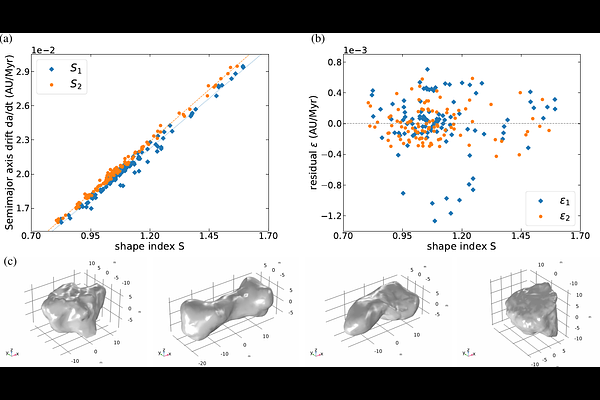Shape index of Yarkovsky effect on irregularly shaped asteroids

Shape index of Yarkovsky effect on irregularly shaped asteroids
Yining Zhang, Yang-Bo Xu, Zehua Qi, Li-Yong Zhou, Jian-Yang Li
AbstractThe Yarkovsky effect on real asteroids is complicated to calculate either by analytical or numerical methods, since they are generally irregular in shape. We propose an index to properly characterise the shape of any asteroid, through which the Yarkovsky effect can be easily calculated without the heavy computations of surface temperatures. By analysing the energy absorbed and then emitted by a surface element, we find that the effective working power produced by the radiation recoil force on this surface element and its contribution to the Yarkovsky effect are both proportional to the double projected area of the surface element. The normalized total projected area over the asteroid's surface is defined as the shape index ($S_1$). We model the Yarkovsky effects of different asteroids using multiphysics software COMSOL, and take the rate of semi-major axis drift ($d a/d t$) obtained in these numerical simulations as the measurement of the strength of Yarkovsky effect. A linear relationship between $d a/d t$ and $S_1$ is confirmed. The shape index is then improved by taking the shadowing effect into account. A much better linear relationship is found between $d a/d t$ and the improved index $S_2$. This linear relationship is obeyed very well in a wide range of thermal parameter values. The influences of scattering and self-heating effects on the linear relationship are found ignorable. Using the shape index and the linear relation obtained in this paper, the rate of semi-major axis migration due to the Yarkovsky effect can be calculated accurately. Compared with the full numerical modeling of surface temperature and then the thermal radiation on an irregularly shaped asteroid, it is very easy to compute the shape index, which brings great convenience to the estimation of Yarkovsky effect.